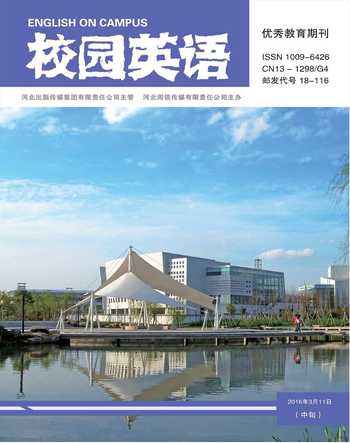A Pragmatic Study on Code-switching in Chinese Network Chat
周薇
【Abstract】Under the theoretical guideline of politeness principle, this paper will give a detailed analysis of code-switching with typical examples. It aims to offer things for further code-switching study from the perspective of pragmatics.
【Key words】Code-switching; Politeness Principle; Chinese Network Chat
There are many people who are dependent on Computer-Mediated Communication such as QQ, We Chat, etc. It is extremely common for our youth to use English and Chinese at the same time through QQ or We Chat. We need have a better understanding of code-switching and spread our culture well through code-switching in Chinese network chat.
1. The introduction of code-switching
There is no definite definition about it. From different point of views, the scholars and linguists define code-switching differently.
Generally speaking, the definition of code-switching goes as the following: (1) the switching between one or more languages, or language variety, on the context of a single conversation; (2) the juxtaposition within the same speech exchange of passage of speech belonging to two different grammatical systems or subways; (3) the selection by bilinguals or multilingual of forms from an embedded variety in utterance of a matrix variety during the same conversation;
2. Politeness theory
From a pragmaticists point of view, “politeness” is the term we use to describe the relationship between how something is said to addressee and that addressees judgments as to how it should be said.
As we all know, Grices Cooperative principle is one of the most influential theory in the use of language in conversation. But Leech thinks it is impossible for Grices Cooperative principle to explain why people need to use many indirect speech acts to violate Cooperative Principle. So, he puts forword the theory of Politeness Principle. Leech puts six maxims in his Politeness Principle, it goes as the following:
1.TACT MAXIM; 2.GENEROSITY MAXIM; 3.APROBATION MAXIAM;4.MODESTY MAXIM; 5.AGREEMENT MAXIM; 6.SIMPATHY MAXIM .
And the above maxims, (1) and (2) are pairs, they are both used in impositives and commissives. (3) and (4) also go in pairs. According to Approbation Maxim, the best way is to praise others when it is necessary and avoid saying unpleasant things about others. The last two implies that both the speaker should seek common points to agree with what the hearer says so as to make a smooth communication.
3. case analysis
It is necessary to apply the theories into case analysis. And there is one example happening two weeks ago in my own school life. On that day, the result of our Japanese examination has been put on the notice. And one of my friends passed the examination with high grade, while her roommate did not pass the examination. At night, in order to comfort her roommate, she chooses to chat with her roommate on the internet as she thinks speaking directly to her is a little embarrassing. And the following is their internet chatting records:
A: 親,不要因为一次考试而沮丧了。Come on, next time. 你是最棒的。
B: Thanks. Congratulations on you. 你才是我要学习的榜样呢!
A: 没呢。大家相互共勉。Thanks.
B: 嗯。Good night!
From the conversation, both A and B are trying to maximize dispraise of self as well as minimize dispraise of other and maximize praise of other. Although A has got high grade, she is still very modest. Through the Code-switching between Chinese and English, she wants to show her praise to the speaker B and minimize the praise of herself. And for the speaker B, maybe she doesnt feel good at present as she failed the Japanese examination, but she does not show any jealousies to the speaker A, on the contrary, she always shows her praise to the speaker A and does not minimize praise of others at all. Faced with this embarrassed situation, most of us may feel it difficult to have a good conversation. But for both A and B, under the guideline of Politeness principle and the usage of code-switching between Chinese and English, they have undertook a successful conversation.
Code-switching in Chinese network chat happens frequently. it is necessary for us to analysis code-switching in Chinese network chat deeply and provide detailed information for further code-switching study from the perspective of pragmatics.
参考文献:
[1]Auter,P.Code-switching in conversation[C].London:Routledge,1995.
[2]卢加伟.语用学视角下的语码转换研究[J].安阳师范学院学报,2006.

